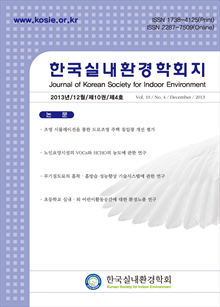간행물
한국실내환경학회지 KCI 등재후보 Journal of Korean Society for Indoor Environment

- 발행기관 한국실내환경학회
- 자료유형 학술지
- 간기 계간
- ISSN 1738-4125 (Print)2287-7509 (Online)
- 수록기간 2004 ~ 2013
- 주제분류 공학 > 환경공학 공학 분류의 다른 간행물
- 십진분류KDC 547DDC 697
권호리스트/논문검색
Vol. 10 No. 4 (2013년 12월) 4건
1.
2013.12
구독 인증기관 무료, 개인회원 유료
The light trespass problem still has not been solved for a long time because of the complex influences of the reflection or overlap lights. To solve the light trespass problem, the assessment of the characteristics of the spilt light carry out firstly. In this study, we estimated the light trespass reducing performance of various load lightings using by RELUX lighting simulation program. In the simulation program, we designed the lighting environment according to the streetlight installation guideline by the ministry of land, transport and maritime affairs. And we estimated the light trespass caused by roadway lighting from first floor position to fourth floor position. And we compare the light trespass caused by back light of the roadway lighting with the light trespass caused by forward light. Then we estimated the effect of light trespass by improving the light distribution of roadway lighting from Backlight rating 3 to Backlight rating zero. From the research, we find that the light trespass caused by roadway lighting maximize at the first floor position of the house. And the light trespass contribution rate by backlight and forward light is 66 percentage and 33 percentage respectively. And we estimated that the light trespass can be decreased about 40 % by improving the backlight. The result derived from this research will be helpful to establish the light pollution reduction plan to minimize the adverse effect by the spilt light from the roadway lighting.
4,000원
2.
2013.12
구독 인증기관 무료, 개인회원 유료
In this study, the characteristic of the facilities and indoor environment for the senior citizens nursing facilities of Kyeonggki and Seoul-total 30 facilities;10 facilities in Seoul and 20 facilities in Kyeonggki from January to December in 2007. In the result of surveying indoor and outdoor pollution degree of 30 senior citizens nursing facilities, the average geometric concentration of indoor and outdoor TVOCs were 264.11 ㎍/㎥ and 162.63 ㎍/㎥, respectively. On the other hand, the average geometric concentration of indoor and outdoor HCHO were 22.76 ㎍/㎥ and 9.55 ㎍/㎥, respectively. The concentration ratio of indoor and outdoor air pollutants were 1.21, 1.23, 1.62 and 2.38 for benzene, toluene, TVOCs and HCHO, respectively. The concentrations of toluene, TVOCs and HCHO were 31.40 ㎍/㎥, 274.30 ㎍/㎥ and 24.17 ㎍/㎥ in the building constructed after 2000. On the other hand, The concentrations of toluene, TVOCs and HCHO were 27.99 ㎍/㎥, 248.54 ㎍/㎥ and 20.48 ㎍/㎥ in the building constructed before 2000. As the constructed year was not late, low concentration was indicated. In the facilities using carpet or not, the concentration of toluene, TVOCs and HCHO were 50.50 ㎍/㎥, 342.73 ㎍/㎥ and 32.94 ㎍/㎥, respectively, in the facilities using carpet. On the other hand, the concentration of toluene, TVOCs and HCHO were 29.35 ㎍/㎥, 261.41 ㎍/㎥ and 22.40 ㎍/㎥, respectively, in the facilities using no carpet. The concentrations were presented higher in the facilities where carpet exits.
5,100원
3.
2013.12
구독 인증기관 무료, 개인회원 유료
Recently, functional building materials which are made of sorption materials have been widely used as board products, inorganic paints and wall papers. These remove chemical substances(VOCs, HCHO) from indoor air by physical sorption or chemical reaction and control humidity by capillary condensation. Also these materials have been used as countermeasures to sick building syndrome (SBS). However, in case of using internal building materials, the hazardous substances affecting to indoor air quality are emitted from not only the material itself but also the subsidiary materials such as adhesives for construction. Particularly in case of wallpaper and flooring material, the amount of emission from adhesives for construction is larger than that from the material itself. Therefore, this research tried to develop a technology system that can improve the performance of adsorption, absorption and desorption of moisture including the construction process that can affect to indoor air quality. To attend this end, ‘porous securement manufacturing technology system’ and ‘porous keeping construction technology system’ are developed that can secure more micropores in the process of production and construction of inorganic paint and maintain them. Consequently the reduction performance of chemical substances(VOCs, HCHO) concentrations and the humidity control performance improved almost over 30% by the technology system of the Inorganic paint.
4,000원
4.
2013.12
구독 인증기관 무료, 개인회원 유료
An elementary school is an important public place for children and it is where they spend most of their days. Ten elementary schools of environmental pollutants were measured in the classroom, playground and school zones (June 19 ~ Nov 1, 2012). Dust measurements of some schools were more indoor air. Measurements of black carbon concentrations were higher overall school zones. Also, in the case of formaldehyde, benzene and some environmental standards were exceeded. In the case of outdoor pollutants not statistically significant, but in some cars and vans that were correlated with pollutants. Thus, strategies and actions are necessary that will protect the health of children in schools from environmental pollutants.
4,800원

